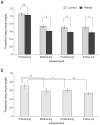Intensive meditation training improves perceptual discrimination and sustained attention
- PMID: 20483826
- PMCID: PMC3132583
- DOI: 10.1177/0956797610371339
Intensive meditation training improves perceptual discrimination and sustained attention
Abstract
The ability to focus one's attention underlies success in many everyday tasks, but voluntary attention cannot be sustained for extended periods of time. In the laboratory, sustained-attention failure is manifest as a decline in perceptual sensitivity with increasing time on task, known as the vigilance decrement. We investigated improvements in sustained attention with training (approximately 5 hr/day for 3 months), which consisted of meditation practice that involved sustained selective attention on a chosen stimulus (e.g., the participant's breath). Participants were randomly assigned either to receive training first (n = 30) or to serve as waiting-list controls and receive training second (n = 30). Training produced improvements in visual discrimination that were linked to increases in perceptual sensitivity and improved vigilance during sustained visual attention. Consistent with the resource model of vigilance, these results suggest that perceptual improvements can reduce the resource demand imposed by target discrimination and thus make it easier to sustain voluntary attention.
Conflict of interest statement
The authors declared that they had no conflicts of interest with respect to their authorship or the publication of this article.
Figures




References
-
- Brown D, Forte M, Dysart M. Visual sensitivity and mindfulness meditation. Perceptual and Motor Skills. 1984;58:775–784. - PubMed
-
- Buddhaghosa . In: The path of purification. Nanamoli B, editor. Kandy, Sri Lanka: Buddhist Publication Society; 1979.
-
- Correa Á, Lupiáñez J, Madrid E, Tudela P. Temporal attention enhances early visual processing: A review and new evidence from event-related potentials. Brain Research. 2006;1076:116–128. - PubMed
Publication types
MeSH terms
Grants and funding
LinkOut - more resources
Full Text Sources
Medical

